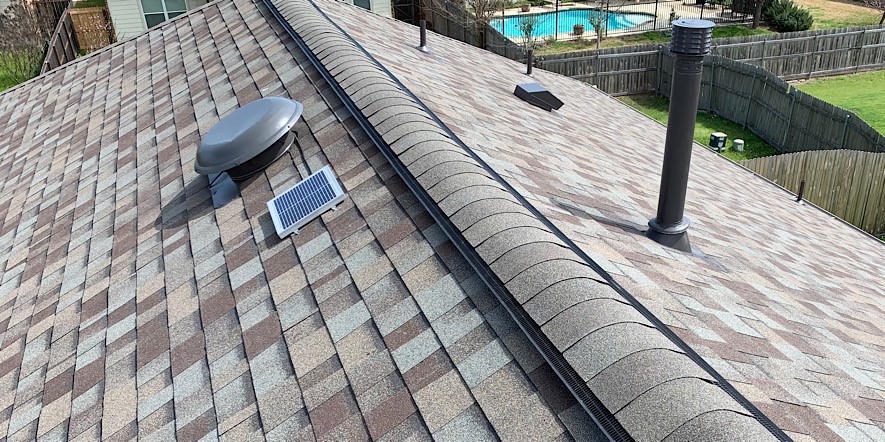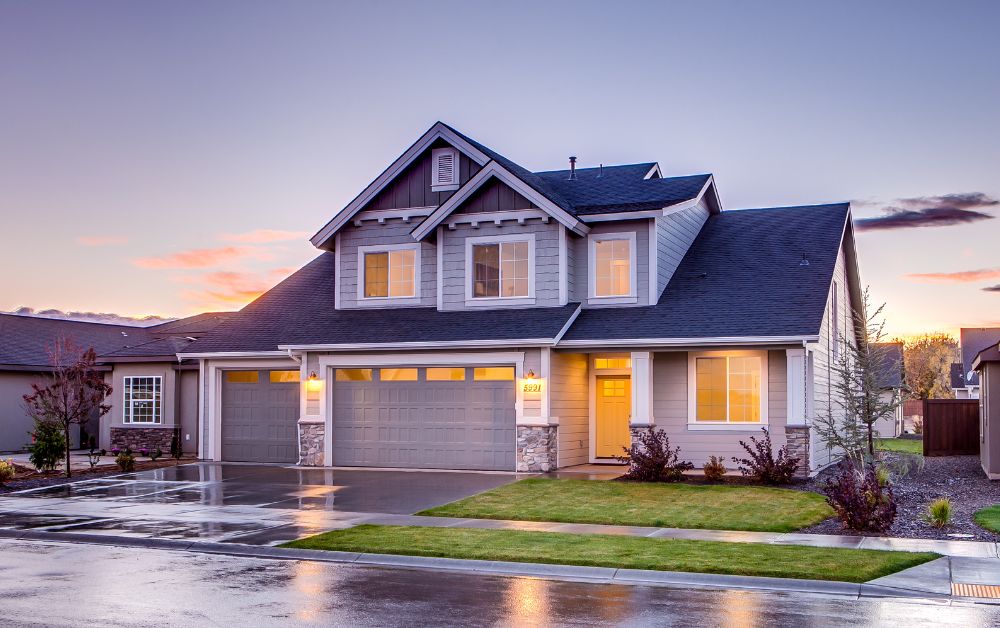
Have you ever thought about installing a roof ventilation system in your home? Proper roof ventilation can do more than just extend the lifespan of your roof. It can also reduce energy costs and improve the comfort of your home.
But what exactly is roof ventilation, and how does it work? In this blog post, you’ll explore the various types of roof ventilation. Also, you’ll get to know some tips to ensure that your roof is properly ventilated.
Let’s talk about roof ventilation first.
What is roof ventilation?
Roof ventilation is when air circulates through roof spaces like attics. Air can flow in and out of the roof through vents, fans, or other systems. It regulates the temperature and humidity in the roof structure.
You don’t want heat and moisture to accumulate, which can damage your roof over time. If you want your roof to last longer, you should install roof vents at the roof’s peak and at the eaves or soffits.
It’s not a good idea to put ventilation in the middle of your roof. It’s just going to stop the air from flowing naturally. The goal is to evenly distribute the vents so the whole attic stays cool.
Why do roofs get moist?

The average home produces about 15 liters of moisture each day. There are a lot of reasons why roof spaces get moist. The first thing you need to do is figure out where the moisture is coming from.
Also read: Roof replacement in Texas
Next, ensure that your home has a proper roof ventilation system. Look at some ways how roof gets moist:
1. Residents’ activities
Bathing, washing clothes, cooking, and taking showers all produce a lot of moisture. To deal with these moisture sources, make sure the roof has enough ventilation.
2. Building materials
It’s common for newly built buildings to have a lot of moisture in them. It can take up to two years for it to dry completely. During that time, the roof needs to vent moisture.
3. Weather
Other sources of moisture include heavy rainfall and high humidity. Even though a well-built roof should keep out the majority of rainwater. A few drops may still get through.
It’s usually nothing to worry about. But a leaky roof is a more serious problem that needs to be fixed.
The importance of proper roof ventilation system

Roof ventilation is critical for a number of reasons, including
Extending the lifespan of your roof
Roof ventilation can help your roof last longer. You can do this by reducing the amount of heat and moisture that builds up inside the roof. It can prevent ice dams in cold weather. Additionally, it prevents mold and other harmful organisms from growing.
Cutting your energy bills
Now you must be wondering how roof ventilation reduces your energy bills. You can reduce energy costs by letting hot air escape from your attic. That means lower home temperatures and less stress on the HVAC system.
Adding comfort
Your home will be more comfortable if you have proper roof ventilation. It helps regulate humidity and temperature in the living area. Your home will feel more comfortable and pleasant, especially during the summer.
Protecting your structure
When moisture and hot air are trapped inside a roof structure, it can expand and contract. Over time, it can cause structural problems. It’s easy to prevent this type of damage with proper roof ventilation.
Keeping fires at bay
You can reduce the risk of fire with proper roof ventilation because it lets hot air and gasses escape from the roof. The problem is especially bad in homes with wood stoves because it generates a lot of heat and gasses.
Improving indoor air quality
Proper roof ventilation helps improve indoor air quality by circulating fresh air. By reducing dust, allergens, and other pollutants in the air, you can improve your family’s health and comfort.
Reducing the risk of condensation
It’s essential to have proper roof ventilation to prevent condensation. This is especially critical in homes with a lot of humidity. Moisture can cause mold and other harmful microbes to grow.
Getting rid of ice dams
In cold climates, proper roof ventilation helps prevent ice dams. This happens because the roof allows hot air to escape. Then you don’t have to worry about ice dams, which can seriously damage your roof.
Pest-proofing your attic
Proper roof ventilation can help keep attics pest-free. You’ll get that by letting fresh air circulate through the roof. It can help prevent pests like mice, rats, and insects. If you are not worried about this situation, you could end up with a ruined roof and house.
Also read: Should you replace or repair your roof in Texas
Considering these and other benefits, it’s clear why roof ventilation is important.
Types of roof ventilation systems

Here are several different types of roof ventilation, including
Intake and exhaust vents
Intake vents are designed to bring fresh air into the roof structure. They are typically installed near the peak of the roof. These vents can be passive (such as static vents) or powered (such as fans).
The exhaust vents, however, are designed to let hot air and moisture escape. These are also installed near the peak of the roof.
Continuous soffit vents
Installing soffit vents on your roof has a lot of advantages. Continuous soffit vents are installed along the eaves and can help keep your roof cool. Most soffit vents are made of perforated material, so air can flow in and out.
The first thing soffit vents do is increase the lifespan of your roof. In addition, these vents keep your attic air flowing and balance your roof’s ventilation. Cooler months mean less attic condensation and a lower chance of frozen pipes.
During the warmer months, soffit vents let cold, fresh air into the attic, while roof vents get rid of heated air. You’ll save money on air conditioning because it keeps your house cooler.
Ridge vents
At the peak of the roof, you’ll find ridge vents. They have perforations so air can flow out. A ridge vent helps move air throughout the roof structure and reduces heat and moisture buildup.
Turbine vents
These vents are installed near the roof peak. A turbine spins when the wind blows. As a result, hot air and moisture are drawn out of the roof.
There are several types of turbine vents, including whirlybird vents and turbine fans. Whirlybird vents move air using a simple spinning motion. An air turbine fan uses a motor to spin a turbine, which can move more air than a whirlybird. However, these types of vents can be problematic because they can break, get dented up by hail and get stuck, and be noisy at times.
Roof-mounted fans
A roof-mounted fan is a powered vent installed near the peak of the roof. They run on electricity and take hot air and moisture off the roof. This leads to lower energy bills and better comfort.
Roof fans are typically more effective at ventilating roofs than passive vents. They can move more air and aren’t dependent on natural airflow. You can get roof-mounted fans for your attic or for the whole house.
An attic fan ventilates the attic space. While a whole-house fan ventilates the entire place. Having roof-mounted fans can help improve your home’s ventilation.
You should consider factors like your home’s size, your roof type, and your climate when picking a fan. For the fan to work properly, you should hire a qualified professional to install it. You can contact us to book a free appointment and get the best roofing solution.
Also read: Can Texas heat damage my roof?
How can you ensure your roof’s proper ventilation?
Here are some tips for ensuring proper roof ventilation in your home:
1. Determine the ventilation needs of your home
It depends on how big your house is, what kind of roof you have, and where you live as to how much ventilation you need. A qualified professional can help you figure out your home’s ventilation needs.
2. Choose the right roof ventilation system
There are several different types of ventilation systems available. Intake vents, exhaust vents, continuous soffit vents, and roof-mounted fans are all examples. As defined earlier.
Choosing a ventilation system that meets your needs is crucial.
3. Make sure proper roof ventilation setup
Installing your ventilation system correctly requires a qualified professional. That way, it’ll work effectively and provide the benefits it’s supposed to.
4. Maintain the roof ventilation system regularly
It’s important to keep your ventilation system maintained and inspected to make sure it’s working properly. It might include cleaning the vents, checking for damage or wear and tear, and making repairs.
5. Consider the location and size of the vents
The location and size of the vents will affect how well they work. Vents should be the right size and installed correctly for proper airflow.
6. Put vents on the upper and lower roofs
You need vents both above and below your roof for proper ventilation. As a result, the whole roof structure gets more airflow.
7. Balance the number of intake and exhaust vents
It’s important to balance intake and exhaust vents for proper ventilation. By doing this, you’ll get better airflow through your roof structure. And you won’t feel hot and humid.
8. Check out your home’s insulation
There’s a link between insulation and roof ventilation. For example, homes with rigid insulation may need more ventilation to ensure enough airflow.
What’s the right way to tell if your roof ventilation system is failing?

You can tell if your roof’s ventilation isn’t working if there are a few signs. Having the right roof ventilation for your place must be your priority. If you experience any of these signs, see a roofing professional.
- The temperature inside the house is high. Poorly ventilated roofs can’t maintain a comfortable interior temperature without proper ventilation.
- You can see signs of damage or degradation on your roof. It could be missing shingles, rotting wood, or anything else.
- Moisture doesn’t build up on a properly vented roof. If you have water stains or flaking paint inside your building, it could ruin the inside.
- In the winter, there is nothing worse than ice dams. The ice melts on the roof because the attic is warm, then freezes again on the overhang. As a result, a dam forms allowing moisture to collect.
Conclusion
Proper roof ventilation system involves a few key factors. The location and size of vents, the balance of intake and exhaust vents, and the type of insulation in your house. Maintaining and checking your ventilation system regularly will help keep it running smoothly. You’ll extend the life of your roof, save energy, and be more comfortable.
We recommend talking to a qualified professional before installing a roof ventilation system. Your home and its occupants will greatly benefit from proper roof ventilation so it’s worth investing in it. Feel free to contact us and get a free roofing consultation.






